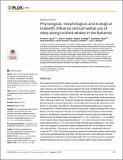Physiological, morphological, and ecological tradeoffs influence vertical habitat use of deep-diving toothed-whales in the Bahamas
Abstract
Dive capacity among toothed whales (suborder: Odontoceti) has been shown to generally increase with body mass in a relationship closely linked to the allometric scaling of metabolic rates. However, two odontocete species tagged in this study, the Blainville’s beaked whale Mesoplodon densirostris and the Cuvier’s beaked whale Ziphius cavirostris, confounded expectations of a simple allometric relationship, with exceptionally long (mean: 46.1 min & 65.4 min) and deep dives (mean: 1129 m & 1179 m), and comparatively small body masses (med.: 842.9 kg & 1556.7 kg). These two species also exhibited exceptionally long recovery periods between successive deep dives, or inter-deep-dive intervals (M. densirostris: med. 62 min; Z. cavirostris: med. 68 min). We examined competing hypotheses to explain observed patterns of vertical habitat use based on body mass, oxygen binding protein concentrations, and inter-deep-dive intervals in an assemblage of five sympatric toothed whales species in the Bahamas. Hypotheses were evaluated using dive data from satellite tags attached to the two beaked whales (M. densirostris, n = 12; Z. cavirostris, n = 7), as well as melon-headed whales Peponocephala electra (n = 13), short-finned pilot whales Globicephala macrorhynchus (n = 15), and sperm whales Physeter macrocephalus (n = 27). Body mass and myoglobin concentration together explained only 36% of the variance in maximum dive durations. The inclusion of inter-deep-dive intervals, substantially improved model fits (R2 = 0.92). This finding supported a hypothesis that beaked whales extend foraging dives by exceeding aerobic dive limits, with the extension of inter-deep-dive intervals corresponding to metabolism of accumulated lactic acid. This inference points to intriguing tradeoffs between body size, access to prey in different depth strata, and time allocation within dive cycles. These tradeoffs and resulting differences in habitat use have important implications for spatial distribution patterns, and relative vulnerabilities to anthropogenic impacts.
Citation
Joyce , T W , Durban , J W , Claridge , D E , Dunn , C A , Fearnbach , H , Parsons , K M , Andrews , R D & Ballance , L T 2017 , ' Physiological, morphological, and ecological tradeoffs influence vertical habitat use of deep-diving toothed-whales in the Bahamas ' , PLoS One , vol. 12 , no. 10 , e0185113 . https://doi.org/10.1371/journal.pone.0185113
Publication
PLoS One
Status
Peer reviewed
ISSN
1932-6203Type
Journal article
Description
The research reported here was financially supported by the United States (U.S.) Navy Office of Naval Research (grant N000140710120; www.onr.navy.mil), the Naval Facilities Engineering Command (grants N002441110021, N002441210007 and contract N6660413P2671; www.navfac.navy.mil), the Strategic Environmental Research and Development Program (award RC-2114; www.serdp.org), and the NOAA Fisheries Acoustic Program (http://www.nmfs.noaa.gov/pr/acoustics/). Graduate student funding support for the first author was provided by the U.S. National Science Foundation Graduate Research Fellowship Program (www.nsfgrfp.org). The relevant data are available from Dryad at DOI: 10.5061/dryad.14v89.Collections
Items in the St Andrews Research Repository are protected by copyright, with all rights reserved, unless otherwise indicated.

